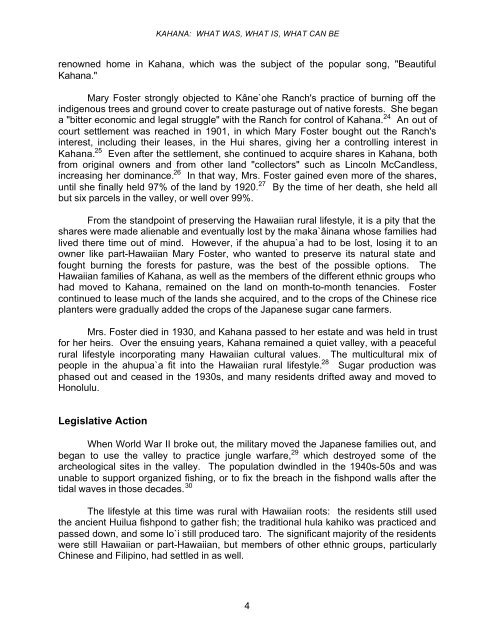Kahana: what was, what is, what can be. - Legislative Reference ...
Kahana: what was, what is, what can be. - Legislative Reference ...
Kahana: what was, what is, what can be. - Legislative Reference ...
Create successful ePaper yourself
Turn your PDF publications into a flip-book with our unique Google optimized e-Paper software.
KAHANA: WHAT WAS, WHAT IS, WHAT CAN BE<br />
renowned home in <strong>Kahana</strong>, which <strong>was</strong> the subject of the popular song, "Beautiful<br />
<strong>Kahana</strong>."<br />
Mary Foster strongly objected to Kâne`ohe Ranch's practice of burning off the<br />
indigenous trees and ground cover to create pasturage out of native forests. She <strong>be</strong>gan<br />
a "bitter economic and legal struggle" with the Ranch for control of <strong>Kahana</strong>. 24 An out of<br />
court settlement <strong>was</strong> reached in 1901, in which Mary Foster bought out the Ranch's<br />
interest, including their leases, in the Hui shares, giving her a controlling interest in<br />
<strong>Kahana</strong>. 25 Even after the settlement, she continued to acquire shares in <strong>Kahana</strong>, both<br />
from original owners and from other land "collectors" such as Lincoln McCandless,<br />
increasing her dominance. 26 In that way, Mrs. Foster gained even more of the shares,<br />
until she finally held 97% of the land by 1920. 27 By the time of her death, she held all<br />
but six parcels in the valley, or well over 99%.<br />
From the standpoint of preserving the Hawaiian rural lifestyle, it <strong>is</strong> a pity that the<br />
shares were made alienable and eventually lost by the maka`âinana whose families had<br />
lived there time out of mind. However, if the ahupua`a had to <strong>be</strong> lost, losing it to an<br />
owner like part-Hawaiian Mary Foster, who wanted to preserve its natural state and<br />
fought burning the forests for pasture, <strong>was</strong> the <strong>be</strong>st of the possible options. The<br />
Hawaiian families of <strong>Kahana</strong>, as well as the mem<strong>be</strong>rs of the different ethnic groups who<br />
had moved to <strong>Kahana</strong>, remained on the land on month-to-month tenancies. Foster<br />
continued to lease much of the lands she acquired, and to the crops of the Chinese rice<br />
planters were gradually added the crops of the Japanese sugar <strong>can</strong>e farmers.<br />
Mrs. Foster died in 1930, and <strong>Kahana</strong> passed to her estate and <strong>was</strong> held in trust<br />
for her heirs. Over the ensuing years, <strong>Kahana</strong> remained a quiet valley, with a peaceful<br />
rural lifestyle incorporating many Hawaiian cultural values. The multicultural mix of<br />
people in the ahupua`a fit into the Hawaiian rural lifestyle. 28 Sugar production <strong>was</strong><br />
phased out and ceased in the 1930s, and many residents drifted away and moved to<br />
Honolulu.<br />
Leg<strong>is</strong>lative Action<br />
When World War II broke out, the military moved the Japanese families out, and<br />
<strong>be</strong>gan to use the valley to practice jungle warfare, 29 which destroyed some of the<br />
archeological sites in the valley. The population dwindled in the 1940s-50s and <strong>was</strong><br />
unable to support organized f<strong>is</strong>hing, or to fix the breach in the f<strong>is</strong>hpond walls after the<br />
tidal waves in those decades. 30<br />
The lifestyle at th<strong>is</strong> time <strong>was</strong> rural with Hawaiian roots: the residents still used<br />
the ancient Huilua f<strong>is</strong>hpond to gather f<strong>is</strong>h; the traditional hula kahiko <strong>was</strong> practiced and<br />
passed down, and some lo`i still produced taro. The signifi<strong>can</strong>t majority of the residents<br />
were still Hawaiian or part-Hawaiian, but mem<strong>be</strong>rs of other ethnic groups, particularly<br />
Chinese and Filipino, had settled in as well.<br />
4
















